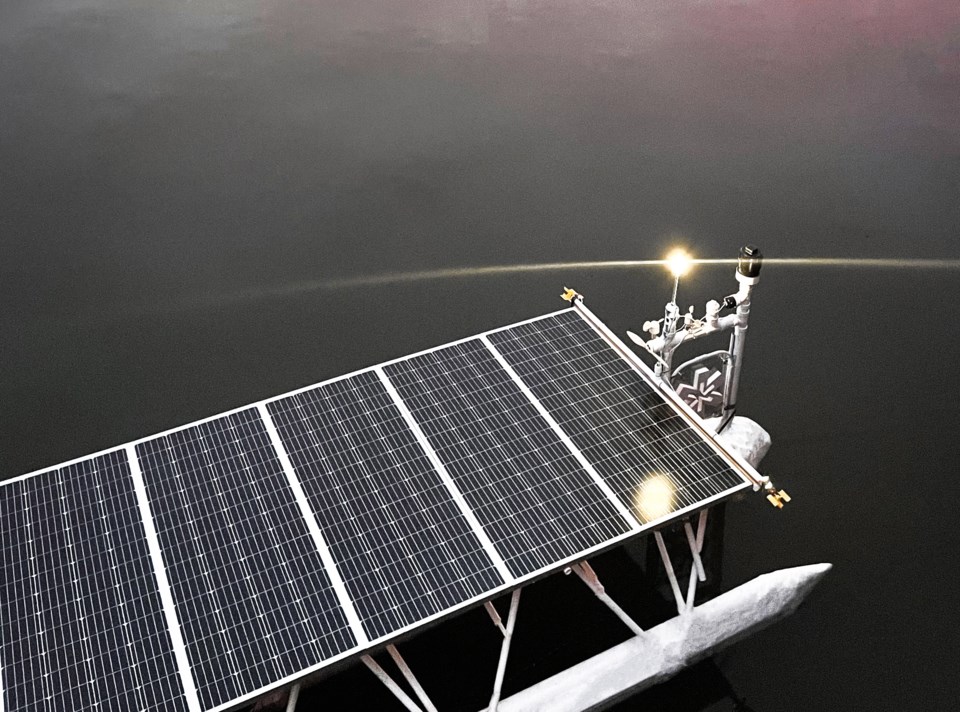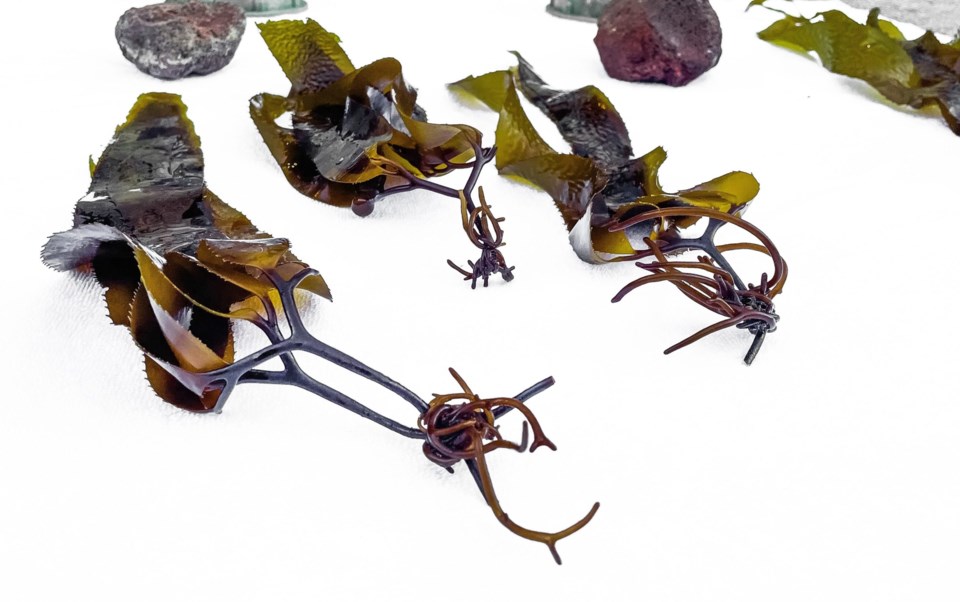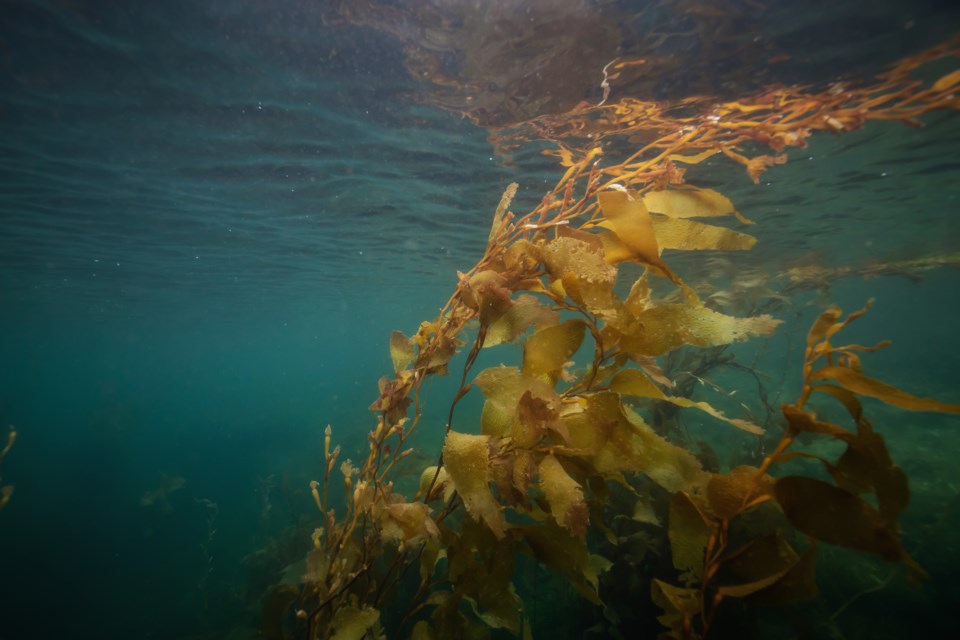Imagine a vessel, about five cars long, skimming its way across the ocean as the sun glints off its solar-panelled roof. Guided by satellites, it keeps a low profile as it steers and manoeuvres itself through the water.
Suddenly, it detects a huge floating mass nearby. It snakes its way towards it, capturing the bobbing seaweed and sealing its fate to the ocean floor.
Soon, the seaweed will be encapsulated in a bottomless cage and plunged down into the ocean until its buoyancy is cancelled out by the immense pressure. From there, it will drop to the ocean floor and along with it, will be the carbon it sequestered during its time at the surface.
This is the operation that Pull to Refresh, a carbon sequestration company founded in 2021, is dreaming up. With vessel prototypes already constructed, the company’s goal is simple: to sink seaweed and reverse emissions.
A qualified competitor in the XPRIZE Carbon Removal competition, Pull to Refresh’s team of three entrepreneurs is focused on using seaweeds, such as Atlantic sargassum and Pacific kelp, to sequester past emissions in the Earth’s atmosphere.

Arin Crumley, co-founder of Pull to Refresh, said the removal of pre-existing emissions from the atmosphere is often overlooked in the rush to reach net-zero emissions.
“Many people focus on getting to zero, which is a great goal,” Crumley said. “But that won't address all of the past emissions that are then going to need to be dealt with.”
In Canada, the government has committed to achieving net-zero emissions by 2050. While this emissions reduction goal remains necessary to slow climate change, carbon dioxide removal (CDR) has been recognized by the Intergovernmental Panel on Climate Change (IPCC) as a crucial measure that needs to occur in tandem with this goal.
According to an IPCC report released in April, all pathways towards limiting global warming to 1.5 degrees depend upon CDR removing billions of tonnes of carbon dioxide from the atmosphere.
Up until recently, CDR has often been thought of as a land-based process that involves sequestering carbon through vegetation and soil management, the report states. However, the report notes that this carbon can easily be released back into the atmosphere by human or natural disturbances.
But in the depths of the ocean, carbon storage could be much less prone to reversal.
Local potential in uncharted waters
This is one of the many reasons Vancouver-based non-profit Ocean Wise is calling for more research into this method of carbon sequestration, also called abyssal sinking.
In its recent report on seaforestation — the management and care of underwater seaweed forests — in B.C., the organization recommended urgent research into the impact of abyssal sinking on deep ocean environments be completed. The report focused on the use of giant kelp as a source of carbon sequestration.
According to Ocean Wise, B.C.’s 190 square kilometres of coastline kelp beds sequester at least 7,755 tons of carbon dioxide every year. That’s equal to the emissions from 3,900 homes in B.C. heated with natural gas.
Louis Druehl, founder of Canadian Kelp, said kelp’s sequestration capabilities are so vast due to its size.
“A big [giant kelp] plant will look like a good size bush, a hefty bush,” Druehl said. “Whereas almost all the other seaweeds are really quite small.”
But even with this knowledge, Andrew Lang Wong, co-author of the seaforestation report, said there’s still a lot unknown about blue carbon — carbon captured by the world’s ocean and coastal ecosystems.
“We know that kelp traps carbon in its tissues as it grows,” Lang Wong said. “[But] there's a really big knowledge gap in where that carbon ends up and verifying that it's actually getting sequestered versus ending up washed up on the beach.”
Sinking the kelp seems to be a surefire way to ensure that carbon doesn’t end up back in the atmosphere, Lang Wong said. By observing oil deposits and fossils, he said it’s been proven that kelp and the carbon it contains can, in fact, be stored for billions of years at the bottom of the ocean.
However, what hasn’t been proven, is that kelp or sargassum can successfully be purposefully sunk at this scale.
“The big unknown is just what happens if you sink millions or billions of tons of kelp to the seafloor,” Laurel Tincher, co-founder of Pull to Refresh, said. “Nobody really knows.”
Druehl agreed that there’s a big unknown about the whole process. He said there’s an entire ecosystem on the ocean floor that humans are unfamiliar with and that he thinks, could be cause for concern.
“If you have… cultivated kelp on the open ocean and you purposely sink that, you're going to be injected into a stable ecosystem on the bottom,” Druehl said. “And we don't know what that means.”

A variety of contenders
Despite this uncertainty, Pull to Refresh isn’t the first or only team of eager entrepreneurs to navigate these murky waters.
There’s a small contingent of scientists, researchers, seaweed farmers and entrepreneurs all trying to decipher the best way to dip their toes into this ocean-based climate solution.
Running Tide is another company with similar sequestering goals, but an entirely different approach. According to its website, its method involves deploying carbon buoys into the open ocean.
The buoys, made from forestry residue and limestone, are seeded with kelp and rely on ocean currents, sunlight and gravity to help them along their carbon-sequestering journey.
As the limestone dissolves, helping combat ocean acidification, the buoy and kelp slowly lose their buoyancy and begin sinking. After less than three months on the surface, the carbon captured by the kelp is then locked into a deep ocean reservoir, the company’s website states.
Seafields is another company digging into this sinking science. It, just like Pull to Refresh, is focused on the sargassum in the middle of the Atlantic Ocean.
Through nature-based technology, its website states, it will establish aquafarms to grow the seaweed before packing it up into bales to be sunk to the ocean floor. Drones and floating feeder pipes made of seaweed-based bioplastic are some of the materials described that are specific to Seafields's sequestration plans.
While many of these companies have appeared in recent years with a keen focus on abyssal sinking, they’re only a small factor in seaweed’s already booming industry.
In 2020, the global seaweed industry was worth US$11.5 billion, according to Ocean Wise, and it’s expected to grow at a rate of 11.8 per cent until 2026. Mainly done in Asia, seaweed cultivation has been occurring for centuries before its carbon-sequestering capabilities began to be factored in.
At Ocean Wise, Lang Wong said abyssal sinking is continuously thought of as something that could complement kelp cultivation and restoration, but not something they’re prepared to designate its own research to yet.
“[Abyssal sinking] is definitely one of the techniques that needs fairly rigorous research,” Lang Wong told Glacier Media.
He added that there are many other uses for seaweeds, such as kelp, that also offer climate solutions and have more research to back them up.
“It's really important to make sure that there are multiple uses for the kelp and that carbon sequestration is just one of those uses,” Lang Wong said.
“There's a lot of opportunity to kind of pair this carbon opportunity with other activities, like farming for food or restoring kelp forests for ecosystems and the benefits they bring.”
Where to navigate to next?
With a repeated emphasis on the need for more research, Ocean Visions, a network of researchers and academics, is bringing many of these various industry contenders together to work on a comprehensive research framework.
Science director David Koweek said Ocean Visions’ framework outlining the sequestration efficacy and environmental impacts of sinking seaweed could be publicly released as soon as September.
“This research framework is all about trying to lay out that road map or vision that gets us from where we are now — which is not having enough information — to the point where we have enough information to make informed decisions about whether or not to employ this as a strategy,” Koweek said.
In the upcoming report, Koweek said there’s a vision laid out for which “controlled field trials” need to take place in order to answer the most important questions about the practice.
Koweek said the field trials could be completed and begin providing real-world answers to questions surrounding abyssal sinking within a timeline of the next five years.
Regardless of whether the research names seaweed a successful sequestration avenue or a sinking failure, Koweek said CDR remains necessary to stop planet warming beyond one and a half degrees.
“I think CDR is imperative. Where that CDR comes from, in what quantities and in what fractions? I don't think we really know that yet,” he said.
For now, Koweek said he doesn’t think any proposed CDR technologies have advanced sufficiently to the point where their contributions to CDR can be considered.
However, he said he’s hopeful that Ocean Visions’ upcoming research sheds some light on the endeavour that Pull to Refresh, and so many others, are eager to undertake.
“I see the lack of scientific information in the space and I see the enthusiasm for it across so many different individuals and organizations,” Koweek said.
“I'm really happy that I think we're going to be able to plug this gap between the demand for information and the lack of supply of information.”
While more research is on the cusp of being completed, Crumley said the Pull to Refresh team is currently focused on building and attaching its sinking accessory to its vessels.
In the meantime, Crumley said they’re just happy to be a part of this new CDR frontier.
“It's really important to us to develop what's next,” he said. “This is just the very, very beginning of the party. People have hardly arrived, but we're excited to be at the party.”



